Estimating the Effective Elastic Parameters of Nodular Cast Iron from Micro-Tomographic Imaging and Multiscale Finite Elements: Comparison between Numerical and Experimental Results
Abstract
1. Introduction
2. Materials and Methods
2.1. Nodular Cast Iron
2.2. Experimental Tensile Testing
2.3. X-Ray Micro-Tomography, Image Reconstruction, and Image Segmentation
2.4. Homogenization with Finite Elements
3. Results and Discussion
4. Conclusions
Author Contributions
Funding
Acknowledgments
Conflicts of Interest
References
- Fragassa, C.; Minak, G.; Pavlovic, A. Tribological aspects of cast iron investigated via fracture toughness. Tribol. Ind. 2016, 38, 1–10. [Google Scholar]
- Carazo, F.D.; Giusti, S.M.; Boccardo, A.D.; Godoy, L.A. Effective properties of nodular cast-iron A multi-scale computational approach. Comput. Mater. Sci. 2014, 82, 378–390. [Google Scholar] [CrossRef]
- Fernandino, D.O.; Cisilino, A.P.; Boeri, R.E. Determination of effective elastic properties of ferritic ductile cast iron by computational homogenization, micrographs and microindentation tests. Mech. Mater. 2015, 83, 110–121. [Google Scholar] [CrossRef]
- Kasvayee, K.A.; Salomonsson, K.; Ghassemali, E.; Jarfors, A.E.W. Microstructural strain distribution in ductile iron; comparison between finite element simulation and digital image correlation measurements. Mater. Sci. Eng. A 2016, 655, 27–35. [Google Scholar] [CrossRef]
- Landis, E.N.; Keane, D.T. X-ray microtomography. Mater. Charact. 2010, 61, 1305–1316. [Google Scholar] [CrossRef]
- Mrzygłód, B.; Matusiewicz, P.; Tchórz, A.; Olejarczyk-Wożeńska, I. Quantitative Analysis of Ductile Iron Microstructure—A Comparison of Selected Methods for Assessment. Arch. Foundry Eng. 2013, 13, 59–63. [Google Scholar] [CrossRef]
- Chuang, C.; Singh, D.; Kenesei, P.; Almer, J.; Hryna, J.; Huff, R. 3D quantitative analysis of graphite morphology in high strength cast iron by high-energy X-ray tomography. Scr. Mater. 2015, 106, 5–8. [Google Scholar] [CrossRef]
- Yin, Y.; Tu, Z.; Zhou, J.; Zhang, D.; Wang, M.; Guo, Z.; Liu, C.; Chen, X. 3D Quantitative Analysis of Graphite Morphology in Ductile Cast Iron by X-ray Microtomography. Metall. Mater. Trans. A 2017, 48, 3794–3803. [Google Scholar] [CrossRef]
- Zybell, L.; Hütter, G.; Linse, T.; Mühlich, U.; Kuna, M. Size effects in ductile failure of porous materials containing two populations of voids. Eur. J. Mech. A Solids 2014, 45, 8–19. [Google Scholar] [CrossRef]
- Hutter, G.; Zybell, L.; Kuna, M. Micromechanisms of fracture in nodular cast iron: From experimental findings towards modeling strategies—A review. Eng. Fract. Mech. 2015, 144, 118–141. [Google Scholar] [CrossRef]
- Andriollo, T.; Hattel, J. On the isotropic elastic constants of graphite nodules in ductile cast iron: Analytical and numerical micromechanical investigations. Mech. Mater. 2016, 96, 138–150. [Google Scholar] [CrossRef]
- Fragassa, C.; Radovic, N.; Pavlovic, A.; Minak, G. Comparison of mechanical properties in compacted and spheroidal graphite irons. Tribol. Ind. 2016, 38, 49–59. [Google Scholar]
- METALRENS 2017. Available online: http://www.metalrens.com.br/ (accessed on 8 December 2017).
- ASTM E8/E8M-09, Standard Test Methods for Tension Testing of Metallic Materials; ASTM International: West Conshohocken, PA, USA, 2009. [CrossRef]
- Guedes, J.M.; Kikuchi, K. Preprocessing and postprocessing for materials based on the homogenization method with adaptive finite element methods. Comput. Meth. Appl. Mech. Eng. 1990, 83, 143–198. [Google Scholar] [CrossRef]
- Geers, M.G.D.; Kouznetsova, V.G.; Brekelmans, W.A.M. Multi-scale computational homogenization: Trends and challenges. J. Comput. Appl. Math. 2010, 234, 2175–2182. [Google Scholar] [CrossRef]
- Pindera, M.J.; Khatam, H.; Drago, A.S.; Bansal, Y. Micromechanics of spatially uniform heterogeneous media: A critical review and emerging approaches. Compos. Part B 2009, 40, 349–378. [Google Scholar] [CrossRef]
- Hughes, T.J.R.; Levit, I.; Winget, J. An element-by-element solution algorithm for problems of structural and solid mechanics. Comput. Meth. Appl. Mech. Eng. 1983, 36, 241–254. [Google Scholar] [CrossRef]
- Erhel, J.; Traynard, A.; Vidrascu, M. An element-by-element preconditioned conjugate gradient method implemented on a vector computer. Parallel Comput. 1991, 17, 1051–1065. [Google Scholar] [CrossRef]
- Shewchuk, J.R. An Introduction to the Conjugate Gradient Method without the Agonizing Pain; Technical Report for Carnegie Mellon University: Pittsburgh, PA, USA, 1994. [Google Scholar]
- Nguyen, V.D.; Béchet, E.; Geuzaine, C.; Noels, L. Imposing periodic boundary condition on arbitrary meshes by polynomial interpolation. Comput. Mater. Sci. 2012, 55, 390–406. [Google Scholar] [CrossRef]
- Chevalier, Y.; Pahr, D.; Allmer, H.; Charlebois, M.; Zysset, P. Validation of a voxel-based FE method for prediction of the uniaxial apparent modulus of human trabecular bone using macroscopic mechanical tests and nanoindentation. J. Biomech. 2007, 40, 3333–3340. [Google Scholar] [CrossRef] [PubMed]
- Harrison, N.M.; McDonnell, P.F.; O’Mahoney, D.C.; Kennedy, O.D.; O’Brien, F.J.; McHugh, P.E. Heterogeneous linear elastic trabecular bone modelling using micro-CT attenuation data and experimentally measured heterogeneous tissue properties. J. Biomech. 2008, 41, 2589–2596. [Google Scholar] [CrossRef] [PubMed]
- Niebur, G.L.; Feldstein, M.J.; Yuen, J.C.; Chen, T.J.; Keaveny, T.M. High-resolution finite element models with tissue strength asymmetry accurately predict failure of trabecular bone. J. Biomech. 2000, 33, 1575–1583. [Google Scholar] [CrossRef]
- Rietbergen, B.; Weinans, H.; Huiskes, R.; Odgaardt, A. A new method to determine trabecular bone elastic properties and loading using micromechanical finite-element models. J. Biomech. 1995, 28, 69–81. [Google Scholar] [CrossRef]
- Ulrich, D.; Rietbergen, B.; Weinans, H.; Ruegsegger, P. Finite element analysis of trabecular bone structure: A comparison of image-based meshing techniques. J. Biomech. 1998, 31, 1187–1192. [Google Scholar] [CrossRef]
- Arns, C.H.; Knackstedt, M.A.; Pinczewski, W.V.; Garboczi, E.J. Computation of linear elastic properties from microtomographic images: Methodology and agreement between theory and experiment. Geophysics 2002, 67, 1396–1405. [Google Scholar] [CrossRef]
- Garboczi, E.J.; Day, A.R. An algorithm for computing the effective linear elastic properties of heterogeneous materials: Three-dimensional results for composites with equal phase poisson ratios. J. Mech. Phys. Solids 1995, 43, 1349–1362. [Google Scholar] [CrossRef]
- Garboczi, E.J.; Berryman, J.G. Elastic moduli of a material containing composite inclusions: Effective medium theory and finite element computations. Mech. Mater. 2001, 33, 455–470. [Google Scholar] [CrossRef]
- Makarynska, D.; Gurevich, B.; Ciz, R.; Arns, C.H.; Knackstedt, M.A. Finite element modelling of the effective elastic properties of partially saturated rocks. Comput. Geosci. 2008, 34, 647–657. [Google Scholar] [CrossRef]
- Roberts, A.P.; Garboczi, E.J. Computation of the linear elastic properties of random porous materials with a wide variety of microstructure. Proc. R. Soc. Lond. A 2002, 458, 1033–1054. [Google Scholar] [CrossRef]
- Yu, W. A unified theory for constitutive modeling of composites. J. Mech. Mater. Struct. 2016, 11, 379–411. [Google Scholar] [CrossRef]
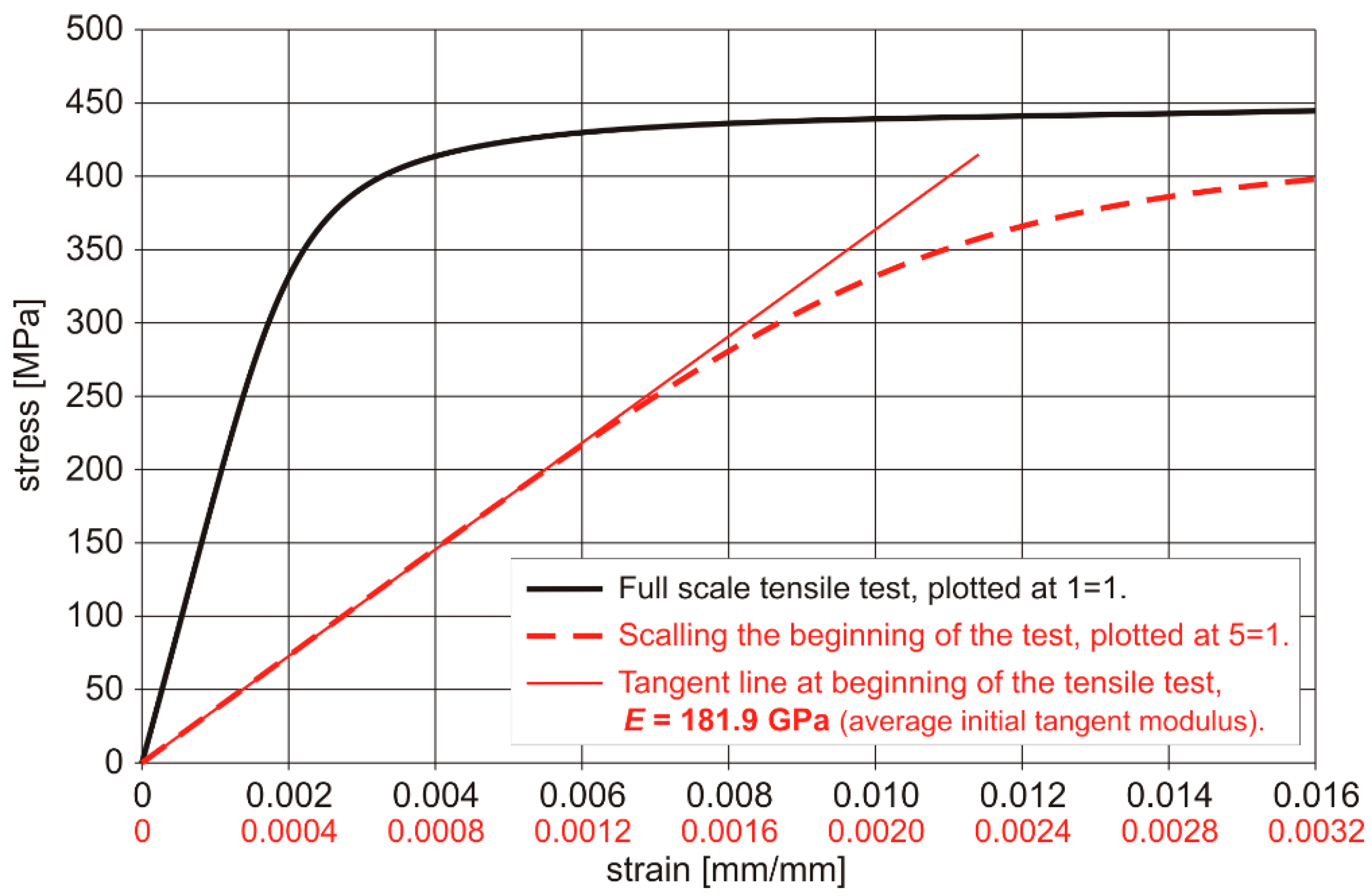


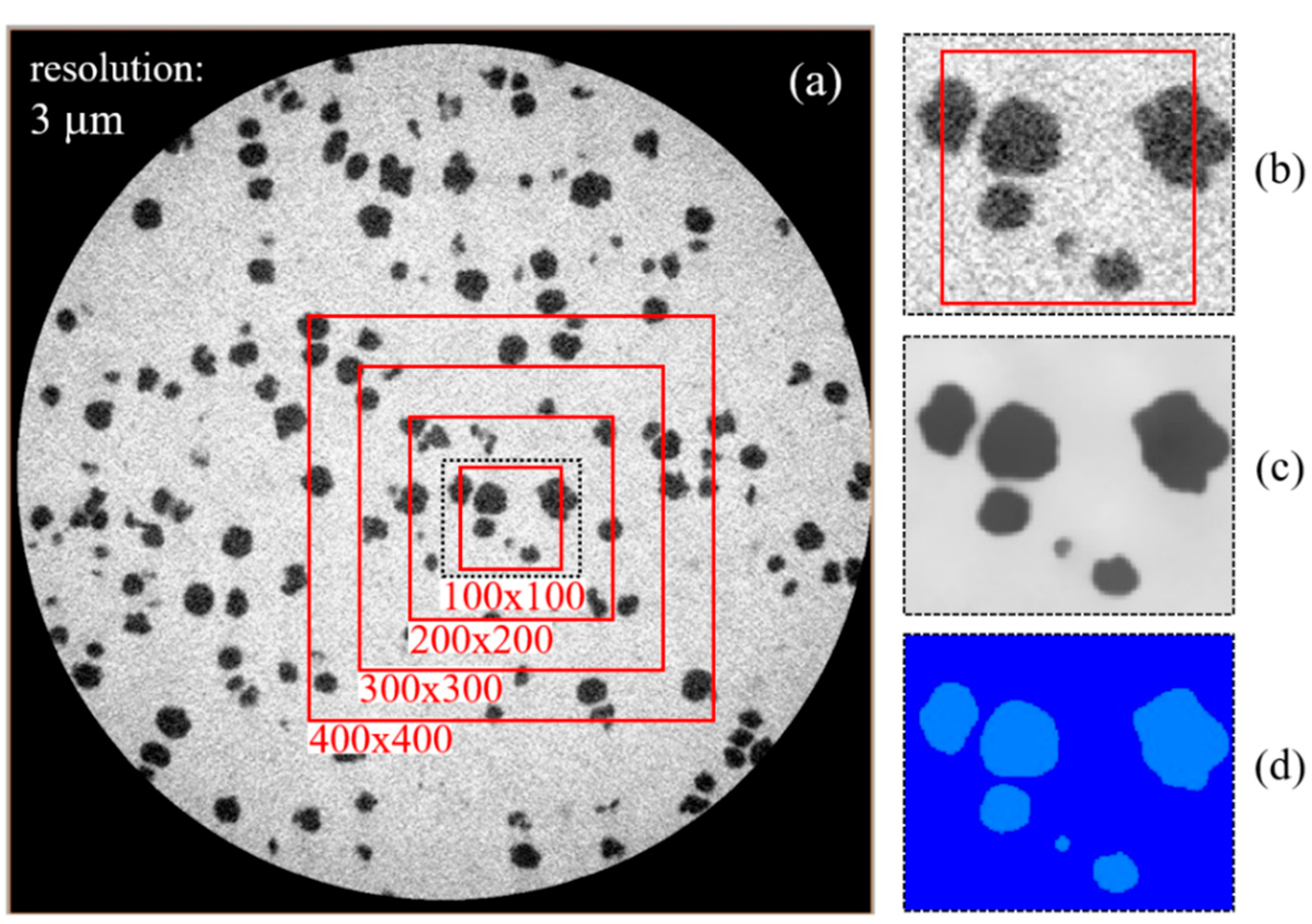
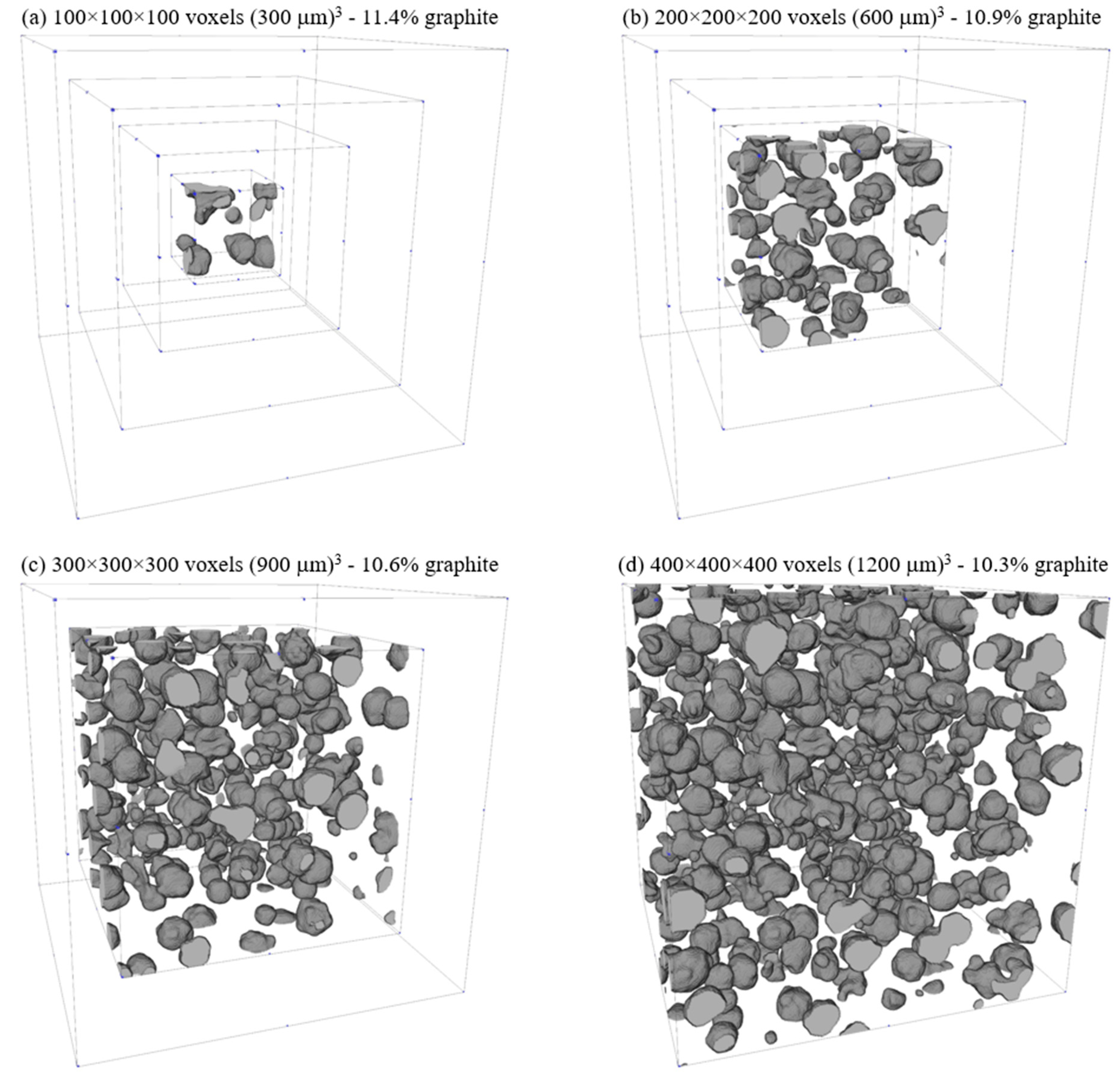
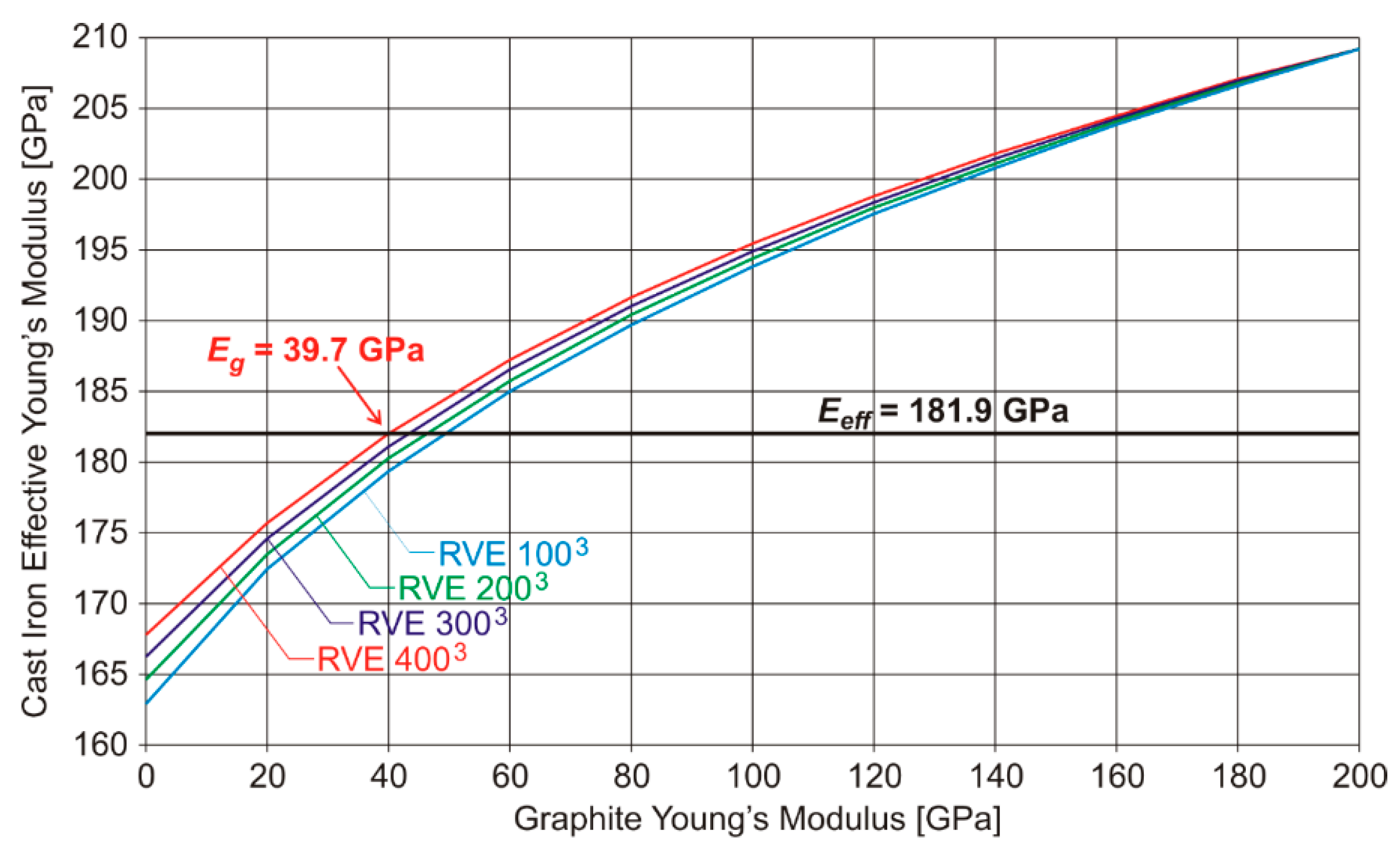
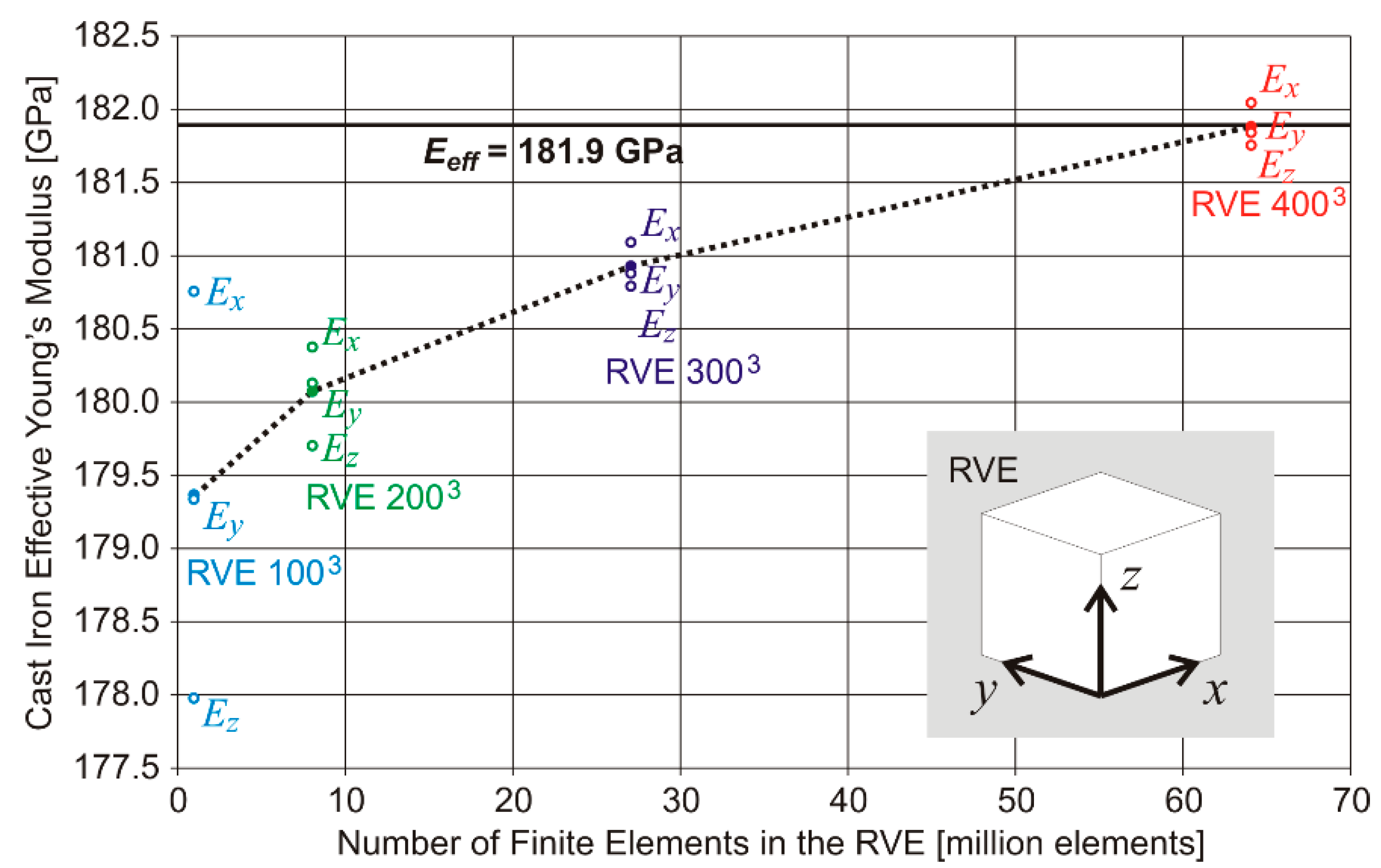
| Resolution (Voxel Size) | Sample-Source Distance | Sample-Detector Distance | Optical Magnify-Cation | Filter (HE = High-Energy) | Beam Energy | Power | Exposure Time | Number of Projections |
|---|---|---|---|---|---|---|---|---|
| 11 μm | 30 mm | 158 mm | 0.4× | HE#4 | 160 kV | 10 W | 3.0 s | 3200 |
| 3 μm | 28 mm | 35 mm | 4.0× | HE#4 | 160 kV | 10 W | 10.0 s | 3200 |
| 1 μm | 26 mm | 150 mm | 4.0× | HE#6 | 160 kV | 10 W | 60.0 s | 1600 |
| Effective Elastic-Modulus | RVE 100 × 100 × 100 | RVE 200 × 200 × 200 | RVE 300 × 300 × 300 | RVE 400 × 400 × 400 |
|---|---|---|---|---|
| Ex (GPa) | 180.757 | 180.376 | 181.090 | 182.043 |
| Ey (GPa) | 179.338 | 180.129 | 180.876 | 181.838 |
| Ez (GPa) | 177.976 | 179.700 | 180.790 | 181.752 |
| Average (GPa) | 179.357 | 180.068 | 180.919 | 181.878 |
© 2018 by the authors. Licensee MDPI, Basel, Switzerland. This article is an open access article distributed under the terms and conditions of the Creative Commons Attribution (CC BY) license (http://creativecommons.org/licenses/by/4.0/).
Share and Cite
Pereira, A.; Costa, M.; Anflor, C.; Pardal, J.; Leiderman, R. Estimating the Effective Elastic Parameters of Nodular Cast Iron from Micro-Tomographic Imaging and Multiscale Finite Elements: Comparison between Numerical and Experimental Results. Metals 2018, 8, 695. https://doi.org/10.3390/met8090695
Pereira A, Costa M, Anflor C, Pardal J, Leiderman R. Estimating the Effective Elastic Parameters of Nodular Cast Iron from Micro-Tomographic Imaging and Multiscale Finite Elements: Comparison between Numerical and Experimental Results. Metals. 2018; 8(9):695. https://doi.org/10.3390/met8090695
Chicago/Turabian StylePereira, Andre, Marcio Costa, Carla Anflor, Juan Pardal, and Ricardo Leiderman. 2018. "Estimating the Effective Elastic Parameters of Nodular Cast Iron from Micro-Tomographic Imaging and Multiscale Finite Elements: Comparison between Numerical and Experimental Results" Metals 8, no. 9: 695. https://doi.org/10.3390/met8090695
APA StylePereira, A., Costa, M., Anflor, C., Pardal, J., & Leiderman, R. (2018). Estimating the Effective Elastic Parameters of Nodular Cast Iron from Micro-Tomographic Imaging and Multiscale Finite Elements: Comparison between Numerical and Experimental Results. Metals, 8(9), 695. https://doi.org/10.3390/met8090695





